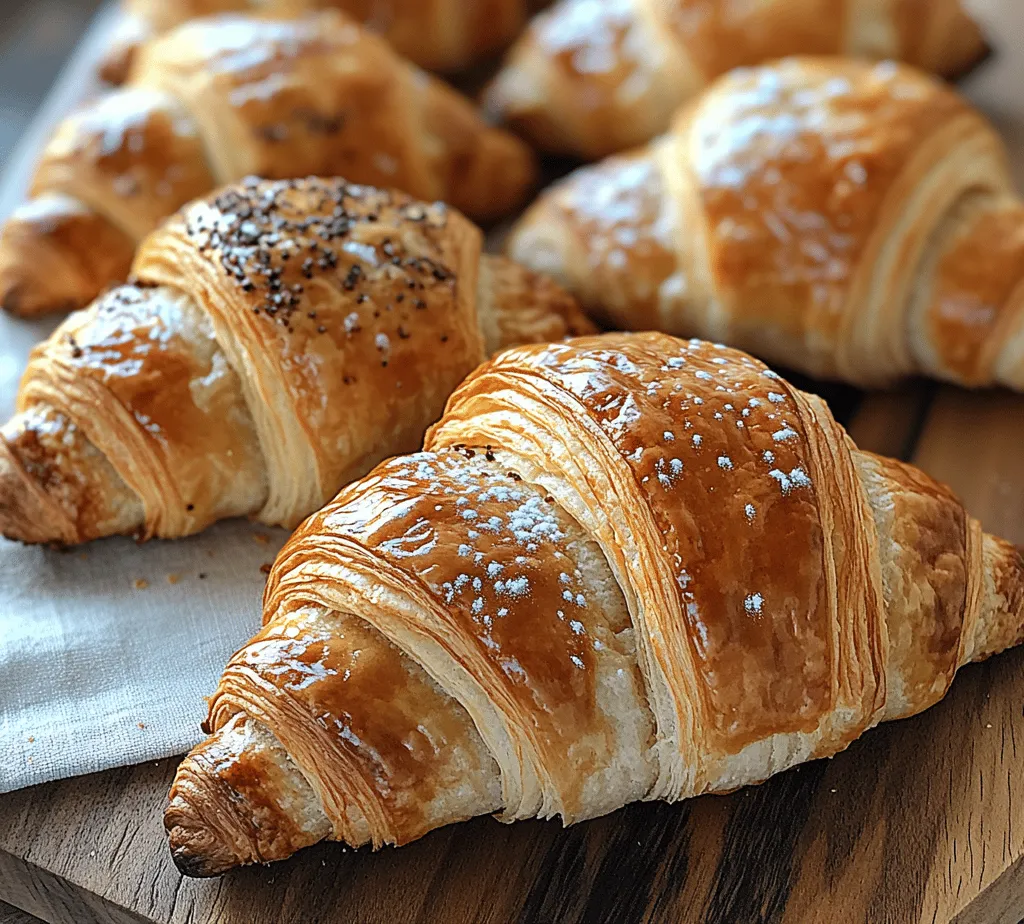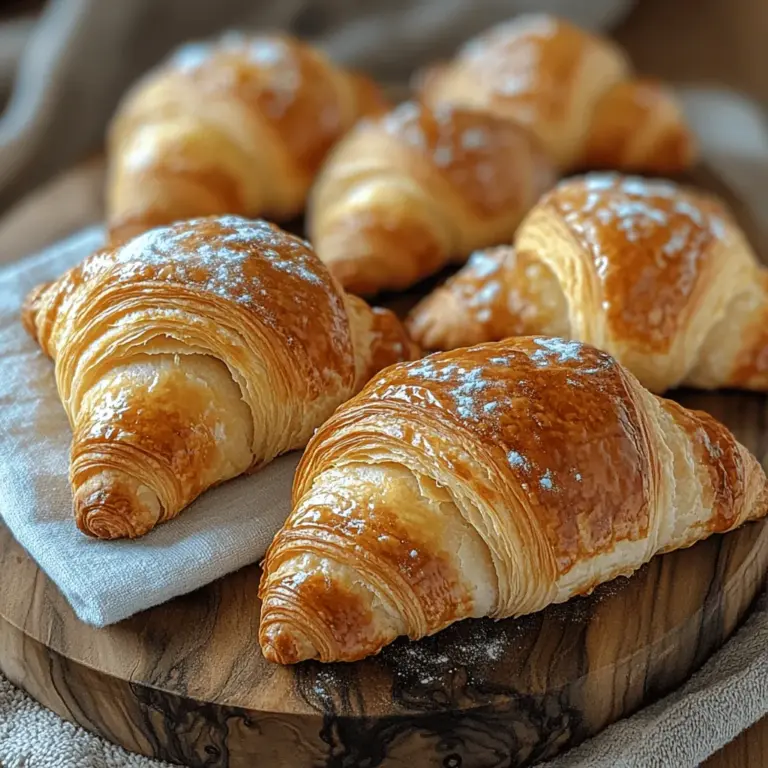Introduction
The allure of homemade croissants is undeniable. Picture this: the aroma of freshly baked pastries wafting through your kitchen, the anticipation building as you await that first, satisfying bite. Croissants are not just a treat; they are an experience, a delightful marriage of flakiness and buttery goodness that elevates any breakfast or brunch. The golden, delicate crust gives way to layers of soft, airy dough, creating a satisfying texture that is hard to resist. When you make croissants at home, you are not just cooking; you are crafting a piece of culinary art that can impress anyone, from family to friends.
The hallmark of a great croissant lies in its flaky texture and rich flavor. This recipe, “Golden Delight: Flaky Butter Croissants,” will guide you through the intricate process of making these French masterpieces from scratch. In this article, we will cover everything you need to know, from the essential ingredients and their roles to the step-by-step method and tips for achieving success. Let’s embark on this journey to create croissants that will leave you and your guests craving more.
Understanding the Basics of Croissant Making
Definition of Croissants and Their Culinary Significance
Croissants are a type of pastry that is celebrated for their unique texture and distinctive crescent shape. Originating from France, these delicious treats are made from a layered yeast-leavened dough that is rolled and folded multiple times to create a light, flaky structure. The process involves a technique known as lamination, which is crucial for achieving the airy layers that croissants are famous for. Their versatility allows them to be enjoyed plain, filled with chocolate, almond paste, or even savory ingredients, making croissants a staple in bakeries and households around the world.
Historical Background of Croissants and Their Origins
The origins of croissants can be traced back to the 13th century, although their modern version is often attributed to 17th-century Austria. The name “croissant,” which means “crescent” in French, is said to have been inspired by the shape of the pastries. Legend has it that the croissant was born as a celebration of the defeat of the Ottoman Empire by the Austrians in 1683, symbolizing the crescent moon found on the Ottoman flag. It was in Vienna that the kipferl, a crescent-shaped pastry, was created. This pastry eventually made its way to France, where the French bakers refined the technique, adding layers of butter and yeast to create the flaky delight we enjoy today.
Explanation of the Unique Dough Preparation Technique Known as Laminating
The secret to the perfect croissant lies in a technique called lamination. This process involves folding a layer of cold butter into the dough multiple times, creating distinct layers that puff up during baking. As the croissant bakes, the water in the butter turns to steam, separating the layers and creating that characteristic flaky texture. Mastering the art of lamination is crucial for any aspiring croissant maker, as it directly impacts the final product. The process may seem daunting, but with practice and patience, you can achieve bakery-quality croissants in your own kitchen.
Ingredient Breakdown for Flaky Butter Croissants
Overview of Essential Ingredients
Creating flaky butter croissants requires attention to detail and quality ingredients. Here’s a breakdown of the essential components that will contribute to your croissants’ flavor and texture:
– All-Purpose Flour: This staple ingredient forms the base of your dough. The protein content in all-purpose flour is key to developing gluten, which provides structure and strength to the croissants while allowing them to rise beautifully.
– Granulated Sugar: Not only does sugar sweeten the dough, but it also aids in browning during baking, giving your croissants a beautiful golden color. Just the right amount of sugar balances the flavors without overpowering the buttery richness.
– Salt: A crucial ingredient in any baked good, salt enhances the flavors of the other ingredients and controls yeast activity. It ensures that the croissants have a well-rounded taste and contributes to the overall structure of the dough.
– Active Dry Yeast: This is the leavening agent that helps the dough rise. It creates the airy texture that is characteristic of croissants. Ensuring your yeast is activated properly is vital for a successful rise.
– Whole Milk: Milk hydrates the dough and adds richness, contributing to the soft texture of the croissants. Using warm milk helps activate the yeast effectively.
– Unsalted Butter: The star of the show, unsalted butter provides the rich flavor and creates the flaky layers that make croissants irresistible. Chilling the butter before use is essential to maintain its structure during the lamination process.
– Egg Wash: A mixture of beaten egg and water brushed on the croissants before baking gives them a beautiful, glossy finish and enhances the golden color. This step is crucial for achieving that professional bakery look.
Tips for Selecting Quality Ingredients for Optimal Results
To achieve the best results with your croissants, always opt for high-quality ingredients. Choose organic, unbleached all-purpose flour for a more natural flavor and texture. When selecting butter, look for European-style butter, which has a higher fat content and will yield even flakier layers. For the yeast, ensure it is fresh and properly stored; expired yeast will not rise effectively. Lastly, use fresh eggs for the egg wash to guarantee that lovely sheen on your croissants.
Step-by-Step Guide to Making Golden Delight Croissants
Activating the Yeast
The first step in making croissants is to activate the yeast, which is crucial for a successful rise. Start by warming your whole milk to around 110°F (43°C). This temperature is warm enough to activate the yeast but not so hot that it kills it.
Once the milk is at the right temperature, sprinkle the active dry yeast over the surface and let it sit for about 5-10 minutes. You will know the yeast is properly activated when it becomes frothy and bubbly. This is a sign that the yeast is alive and ready to work its magic in your dough.
Making the Dough
With your yeast activated, it’s time to make the dough. In a large mixing bowl, combine your all-purpose flour, granulated sugar, and salt. Mix these dry ingredients together thoroughly to ensure even distribution.
Next, create a well in the center of the dry ingredients and pour in the activated yeast mixture along with any remaining milk. Using a wooden spoon or your hands, begin mixing the ingredients until they start to come together. The dough should be slightly sticky but manageable. If it feels too dry, add a little more milk, one tablespoon at a time, until the desired consistency is achieved.
Kneading the Dough
Kneading is a vital step in the croissant-making process, as it develops gluten and gives the dough its strength. Turn the dough out onto a lightly floured surface and begin kneading. Push the dough away from you with the heel of your hand, fold it over, and give it a quarter turn. Repeat this process for about 8-10 minutes until the dough is smooth and elastic.
To check if your dough is ready for rising, perform the “windowpane test.” Take a small piece of dough and stretch it gently. If it stretches without tearing and you can see light through it, you have successfully developed the gluten structure needed for the croissants.
Preparing the Butter Layer
While the dough is resting and rising, it’s time to prepare the butter layer, which is crucial for achieving those signature flaky layers. Start with unsalted butter that has been kept in the refrigerator until firm. Place the cold butter between two sheets of parchment paper or in a large zip-top bag. Using a rolling pin, pound the butter into a rectangular shape, about half an inch thick.
Make sure the butter remains cold during this process; if it begins to soften, return it to the refrigerator for a few minutes. Once you have a smooth rectangle of butter, it’s ready to be incorporated into your dough.
Now that you have the butter layer and the dough prepared, you’re well on your way to creating golden, flaky croissants that will delight your taste buds. The next steps will involve the lamination process and baking, which we will cover in the following part of this article. Stay tuned for the continuation of this delicious journey into the world of homemade croissants.

Incorporating the Butter
To achieve the signature flaky texture of croissants, the incorporation of butter into the dough is paramount. Start by ensuring that your butter is cold but pliable—this is essential for creating distinct layers in the croissant. The ideal temperature for the butter is around 60°F (15°C). If the butter is too soft, it will blend into the dough rather than create the necessary layers.
Techniques for Sealing Butter Within the Dough
Once your dough has been prepared and chilled, it’s time to incorporate the butter. Place a block of cold butter between two sheets of parchment paper and use a rolling pin to pound it gently into a rectangle that measures approximately 8 x 6 inches. This step is crucial as it allows for easier handling and ensures that the butter remains cold as you work.
To seal the butter within the dough, roll out the dough into a rectangle that is roughly double the size of the butter block. Place the butter in the center of the dough and fold the dough over the butter, encasing it completely. Pinch the edges to seal the butter inside, ensuring there are no gaps.
Ensuring Even Distribution of Butter
Even distribution of the butter is vital for achieving the layered effect. To ensure that the butter is evenly spread throughout the dough, begin gently rolling it out into a rectangle. Use even pressure and avoid pressing too hard at any one point, as this can cause the butter to leak out. A gentle touch will help maintain the integrity of the layers.
Rolling and Folding Process
The rolling and folding process, known as “lamination,” is where the magic happens. This technique involves rolling the dough out and folding it multiple times to create layers of dough and butter. Each fold is referred to as a “turn.”
Detailed Explanation of the Rolling and Folding Technique (Turns)
For a classic croissant, you will need to perform a total of three turns. To execute a turn, roll the dough into a long rectangle, about 24 inches long and 8 inches wide. Then, fold the dough into thirds, like a letter. After each turn, wrap the dough in plastic wrap and chill it in the refrigerator for about 30 minutes. This chilling allows the gluten to relax and keeps the butter cold.
– First Turn: Roll the dough into a rectangle, fold it into thirds, and chill.
– Second Turn: Repeat the rolling and folding process, ensuring that the dough is chilled between each turn.
– Third Turn: Finish with one more turn, after which the dough should be well layered and ready for shaping.
Visual Cues for Proper Dough Thickness and Texture
As you roll out the dough, it’s essential to maintain a consistent thickness of roughly 1/4 inch. Visually, the dough should appear smooth and slightly elastic. If it shrinks back while rolling, let it rest for a few minutes before continuing. The layers should be visible but not torn, indicating that the butter has been successfully incorporated.
Shaping the Croissants
Once the dough has completed its turns and has chilled, it’s time to shape your croissants. This process transforms the layered dough into the iconic crescent shape.
Techniques for Cutting and Shaping Croissants
Begin by rolling the dough out into a large rectangle, about 1/4 inch thick. Use a sharp knife or a pizza cutter to slice the dough into long triangles. The base of each triangle should be about 4 inches wide and the height around 8 inches.
To shape the croissants, start at the base of each triangle and gently stretch the dough as you roll it towards the tip. This technique helps create a more pronounced curve in the final croissant. Once rolled, tuck the tip underneath the croissant to secure it.
Tips for Achieving Uniformity in Size and Shape
To ensure that your croissants bake evenly, aim for uniform size and shape. Use a ruler or a template to measure the triangles if necessary. Additionally, try to keep the width of the base consistent across all pieces. This consistency will give you evenly baked croissants with a professional look.
Final Rising
The final rising stage is crucial for achieving fluffy, airy croissants. During this time, the dough will rise and expand, creating the light texture characteristic of a perfect croissant.
Why Final Rising is Crucial for Fluffy Croissants
This stage allows the yeast to activate fully, producing gas that helps the dough rise. Ensuring that your croissants undergo this final rise will contribute to their airy texture and flaky layers. Skipping this step may result in dense pastries.
Ideal Conditions for Dough Rising
For optimal results, place your shaped croissants in a warm, draft-free area. Cover them lightly with a clean kitchen towel or plastic wrap to prevent drying. The ideal temperature for rising is around 75°F (24°C). It should take about 1 to 2 hours for the croissants to double in size.
Baking the Croissants to Perfection
Once your croissants have risen beautifully, it’s time to bake them to achieve that golden-brown perfection.
Preheating the Oven
Before baking, preheat your oven to 400°F (200°C). Preheating is vital because it creates the ideal environment for the croissants to rise rapidly and bake evenly. An adequately heated oven will also contribute to the development of a beautiful crust.
Importance of Temperature for Achieving Golden Brown Croissants
The high temperature of the oven is what gives croissants their signature golden color. The initial heat causes the moisture in the dough to evaporate rapidly, creating steam that helps the croissants puff up.
Applying Egg Wash
An egg wash, made from whisking together an egg with a splash of water or milk, is key to achieving a shiny, appealing finish on your croissants.
Techniques for Even Application of Egg Wash
Using a pastry brush, gently apply the egg wash to the surface of each croissant before baking. Be careful not to apply too much, as it can pool and prevent even baking. The egg wash should cover the croissants evenly for a beautiful, glossy finish.
Effects of Egg Wash on the Final Appearance
The egg wash not only enhances the appearance but also contributes to a crisp outer layer. It provides that sought-after golden hue and a beautiful sheen that makes croissants irresistible.
Baking Time and Temperature
Bake your croissants for 15 to 20 minutes, or until they are deep golden brown. Visual indicators of perfect croissants include a puffed-up appearance and a beautifully browned crust. Keep an eye on them towards the end of the baking time, as ovens can vary.
Cooling and Enjoying Your Croissants
After baking, allow your croissants to cool on a wire rack. This cooling process is essential as it prevents the bottoms from becoming soggy.
Importance of Cooling on a Wire Rack
Cooling on a rack allows air to circulate around the croissants, ensuring that they remain crisp and flaky. If left on a baking sheet, condensation can form underneath, leading to a loss of that desired texture.
Suggestions for Serving: Plain, with Butter, or as Part of a Breakfast Spread
Croissants can be enjoyed in various ways. Serve them plain, slathered with butter, or even filled with your favorite jam or chocolate for an added treat. They make a perfect addition to any breakfast spread, alongside coffee or tea.
Storage Tips for Maintaining Freshness
If you have leftover croissants, store them in an airtight container at room temperature for up to two days. For longer storage, consider freezing them. Wrap each croissant individually in plastic wrap and place them in a freezer-safe bag. When ready to enjoy, simply reheat them in the oven at 350°F (175°C) for about 10 minutes.
Common Mistakes to Avoid While Making Croissants
Making croissants can be challenging, and several common pitfalls can lead to disappointing results.
Discuss Frequent Pitfalls in the Croissant-Making Process
One common mistake is not keeping the butter cold enough during the lamination process. If the butter melts into the dough, it will not create the necessary layers. Additionally, rushing through the resting and rising times can also affect the final texture.
Tips for Troubleshooting Dough Texture and Rising Issues
If your dough is too sticky, it may need a bit more flour during rolling. Conversely, if it feels too dry, consider adding a small amount of water. If your croissants do not rise properly, it could be due to inactive yeast or not allowing enough time for the final rise.
Importance of Patience and Precision in Baking
Croissant-making requires patience and precision. Take your time during each step, from measuring ingredients accurately to allowing proper rising times. These factors greatly contribute to the quality of the final product.
Conclusion
Making croissants at home is a rewarding experience that brings the joy of baking to life. The satisfaction of crafting these flaky, buttery pastries from scratch is unmatched. With practice, you will master the art of croissant-making, delighting yourself and your loved ones with fresh, warm croissants. Embrace the process, enjoy the transformation of simple ingredients into a culinary masterpiece, and savor the delicious results of your diligent efforts. The journey to perfecting croissants is not only a testament to your baking skills but also a delightful way to share the joy of food with others.

